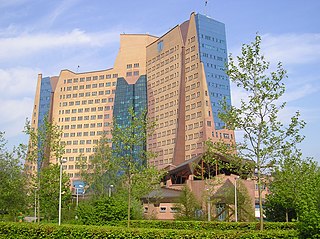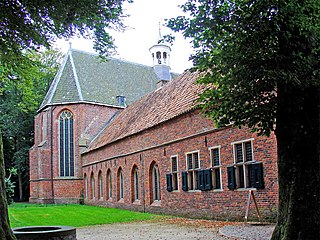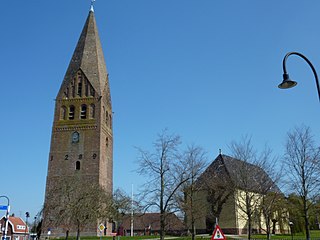Related Research Articles

Groningen is the northeasternmost province of the Netherlands. It borders on Friesland to the west, Drenthe to the south, the German state of Lower Saxony to the east, and the Wadden Sea to the north. As of February 2020, Groningen had a population of 586,309 and a total area of 2,960 km2 (1,140 sq mi).

Groningen is the capital city and main municipality of Groningen province in the Netherlands. The capital of the north, Groningen is the largest place as well as the economic and cultural centre of the northern part of the country; as of December 2021, it had 235,287 inhabitants, making it the sixth largest city/municipality in the Netherlands and the second largest outside the Randstad.

Zwolle is a city and municipality in the Northeastern Netherlands. It is the capital of the province of Overijssel and the province's second-largest municipality, after Enschede, and has a population of 130,592 as of 1 December 2021. Zwolle borders the province of Gelderland and is east of the River IJssel.

Winschoten is a city with a population of 18,518 in the municipality of Oldambt in the northeast of the Netherlands. It is the largest city in the region of Oldambt in the province of Groningen which has 38,213 inhabitants.

The Oldehove is a leaning and unfinished church tower in the medieval centre of the Dutch city of Leeuwarden.

Gronings, is a collective name for some Friso-Saxon dialects spoken in the province of Groningen and around the Groningen border in Drenthe and Friesland. Gronings and the strongly related varieties in East Frisia have a strong East Frisian influence and take a remarkable position within West Low German. The dialect is characterized by a typical accent and vocabulary, which differ strongly from the other Low Saxon dialects.

The Martinitoren is the tallest church steeple in the city of Groningen, Netherlands, and the bell tower of the Martinikerk.

Harkstede ; Gronings: Haarkstee ) is a small village in the northeastern Netherlands. It is located in Midden-Groningen, Groningen. Harkstede is located near the "Meerstad Project" of the municipality of Groningen, however, it is no longer part of the project.


Oldehove is a village in the Dutch province of Groningen. It is located in the municipality of Westerkwartier, about 16 km northwest of the city of Groningen. The town has a notable skyline with two windmills and two of its three churches visible from almost every angle, the third church being obscured from vision by houses and trees because it doesn't have the traditional tower associated with most churches in similar villages.

't Zandt is a village in the Dutch province of Groningen. It is located in the municipality of Eemsdelta.
Aalsum is a small hamlet in the Dutch province of Groningen. It is located in the municipality of Westerkwartier, about 1.5 km west of Oldehove.

The Aa-kerk is a historic former parish church in the centre of Groningen, and a dominant feature in the skyline of the city together with the nearby Martinitoren.

Ter Apel Monastery is a former monastery in the village of Ter Apel in the northeastern Dutch province of Groningen. It is the only monastery in the larger area of Friesland and Groningen that survived the Reformation in a decent condition, and the only remaining rural monastery from the Middle Ages in the Netherlands. The convent buildings house a museum for monastery and church history and for religious art, as well as two contemporary art galleries. The former lay church of the monastery still functions as a reformed church.

The Groningen gas field is a natural gas field in Groningen province in the northeastern part of the Netherlands. With an estimated 2,740 billion cubic metres of recoverable natural gas it is the largest natural gas field in Europe and one of the largest in the world.

Oudeschans is a small village with a population of around 100 in the municipality of Westerwolde in the province of Groningen in the Netherlands. The 16th-century fortification is now a state protected village area with several national heritage sites, among which a 17th-century garrison church, and the Vestingmuseum Oudeschans.

Titia Brongersma was a Frisian poet of the late 17th century. Her book, De bron-swaan, was published in 1686 and is virtually the only trace of her literary activity. She also gained prominence for excavating a dolmen at Borger, Netherlands in 1685.

The west gallery organ in the Aa-kerk in Groningen was built by Arp Schnitger in 1699–1702. Originally built for the Academiekerk in Groningen it was moved to the Aa-kerk in 1815. Today it has 40 stops on three manuals and pedal, and is a monument of European significance.

Schildwolde is a village in the Dutch province of Groningen. It is part of the municipality of Midden-Groningen. It is known for its detached church tower from the 13th century.

Niehove is a village in the municipality of Westerkwartier in Groningen, Netherlands. The village was located on the island of Humsterland in the former Lauwerszee from c. 800 until c. 1500. It is a terp village with two ring roads and the church in the middle. The village is a protected site. In 2019, Elsevier Weekblad named Niehove the most beautiful village of the Netherlands.
References
- ↑ https://ifthenisnow.eu/nl/artikelen/een-weense-gravin-in-oldehove (Dutch language)
- ↑ https://www.dbnl.org/tekst/aa__001biog22_01/aa__001biog22_01_0088.php (excerpt from Biographisch woordenboek der Nederlanden, A.J. van der Aa, 1874)
- ↑ https://monumentenregister.cultureelerfgoed.nl/monumenten/31395 (description Dutch Register of National Monuments)